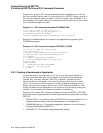Getting Started with DECTPU
2.4 Using Journal Files
2.4.3 Buffer-Change Journal File-Naming Algorithm
By default, DECTPU creates the buffer-change journal file name by using the
following algorithm:
1. Converts all characters in the buffer name that are not alphanumeric, a
dollar sign, underscore, or hyphen to underscores
2. Truncates the resulting file name to 39 characters
3. Adds the file type .TPU$JOURNAL
For example, a buffer named TEST.BAR has a default journal file name of TEST_
BAR.TPU$JOURNAL.
DECTPU puts all journal files in the directory defined by the logical name
TPU$JOURNAL. By default, this logical is defined as SYS$SCRATCH. You can
reassign this logical name. For example, if you want journal files written to the
current default directory, define TPU$JOURNAL as [ ].
2.5 Avoiding Errors Related to Virtual Address Space
DECTPU manipulates data in a process’s virtual memory space. If the space
required by the DECTPU images, data structures, and files in memory exceeds
the virtual address space, DECTPU tries to write part of the data to the work
file, thus freeing up space for other parts of the data that it needs immediately.
If the work file is full, DECTPU attempts to return either a TPU$_GETMEM
or TPU$_NOCACHE error message. Although you may be able to free up some
space by deleting unused buffers, Compaq recommends that you terminate the
DECTPU session if you encounter either of these errors. You can then start a
new session with fewer or smaller buffers. Alternatively, you may want to put
the work file on a disk that contains more free space. Use one of the following
methods to do this:
• Redefine TPU$WORK to point to the disk with more free space.
• Invoke DECTPU with the /WORK=filename qualifier.
DECTPU may be unable to signal an error when it frees up memory by writing to
the work file. In this case, DECTPU aborts with a fatal internal error.
You may be able to avoid writing to the work file by increasing the virtual
address space available to a process. The virtual address space is controlled by
the following two factors:
• The SYSGEN parameter VIRTUALPAGECNT
• The page file quota of the account you are using
The VIRTUALPAGECNT parameter controls the number of virtual pages that
can be mapped for a process. For more information on VIRTUALPAGECNT, see
the description of this parameter in the OpenVMS documentation on the System
Generation Utility (SYSGEN).
The page file quota controls the number of pages in the system paging file that
can be allocated to your process. For more information on the page file quota, see
the description of the /PGFLQUOTA qualifier in the OpenVMS documentation on
the Authorize Utility (AUTHORIZE).
You may need to modify both the VIRTUALPAGECNT parameter and the page
file quota to enlarge the virtual address space.
2–8 Getting Started with DECTPU


















